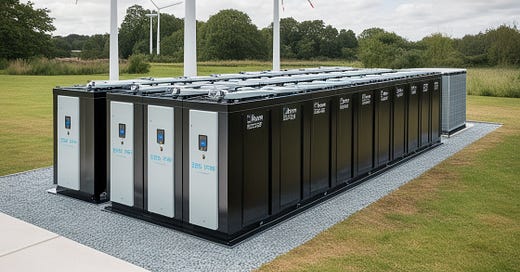Investing into BESS
Tolling agreements - new opportunities on the horizon for infrastructure investors
Renewable energy assets, such as wind and solar farms, are favored by investors due to their predictable revenue streams generated through long-term contracts like government-backed feed-in tariffs, PPAs or CfDs, and more. Battery energy storage systems (BESS) often complement these by storing excess renewable energy for later discharge, enhancing grid stability. However, unlike renewable assets, BESS revenue generation relies on ancillary and wholesale markets, and complex trading strategies to optimize energy buying and selling, exposing investors to market volatility. This revenue uncertainty makes BESS a riskier asset class with more challenging financing options compared to the stable cash flows of renewable energy projects, which benefit from supportive regulatory frameworks. Inherently, higher risk assets require higher returns.
Essentially, renewable energy projects operate in a relatively regulated environment with predictable returns, while BESS function in a more market-based, competitive landscape. Based on my quick-and-dirty analysis, BESS, under a tolling agreement, presents a promising investment opportunity for infrastructure investors.
Consequently, many investors, particularly those specializing in infrastructure assets, have been hesitant to allocate capital to BESS. The asset class is complex, characterized by high risk, the need for daily optimization, and uncertain cash flows. While the UK has seen significant BESS deployment and investor familiarity, the European continent has been more cautious in adopting this asset class. Despite growing interest, continental investors remain relatively hesitant to make initial BESS investments.
One potential approach is to decouple the BESS asset from its trading operations. Richard Twaites, CEO of Penso Power, has shared good news on Twitter. For more details, check out the BW ESS website:
6 August 2024, LONDON — Global energy storage owner-operator BW ESS and its partner, Penso Power, have signed a seven-year tolling agreement with Shell Energy Europe Limited (Shell) for their Bramley Battery Energy Storage System (BESS) currently under construction in Hampshire, UK.
The deal is the first announced long-term tolling agreement for a single BESS asset in Great Britain, creating a template for a new revenue structure that will help to unlock energy storage market opportunities across Europe.
The fixed-price tolling agreement provides revenue certainty for BW ESS and Penso Power while Shell will trade the Bramley BESS into a range of ancillary services and wholesale markets.
The 100MW / 330MWh Bramley site is the first project in Europe to deploy Sungrow’s PowerTitan 2.0 liquid cooled BESS – a system that combines a 2.5MW Power Conversion System using integrated string inverters and a 5MWh battery into a single container. This has enabled BW ESS and Penso Power to deliver a 330MWh project within a relatively small project footprint. Bramley is expected to be the longest duration BESS in the UK at the time of commissioning, which is expected in Q4 this year.wholesale markets.
This model aligns with traditional infrastructure investments: develop and build an asset, then lease it for predictable, long-term income. This fixed-price tolling arrangement provides the capital to develop and finance the asset. The lessee handles daily operations, including complex energy trading, without bearing upfront capital expenditures (CAPEX). This risk-sharing model benefits both parties. Asset owners like BW ESS and Penso Power focus on development and financing, while operators like Shell manage market risks and leverage their trading expertise. Importantly, the asset owner retains responsibility for maintenance to ensure optimal operation and performance.
Tolling Agreement
A tolling agreement is basically a long-term rental contract beween a toller (owner) and an offtaker (lessee). The agreement includes following main parts:
Financial terms: tolling fee structure, duration of the tolling agreement, indemnification, insurance,
Operational terms: asset ownership and maintenance, terms and conditions (e.g. cycle times of BESS.), operational control, force majeure
Legal terms: dispute resolution, confidentiality, insurance
For more information, please check out Enspired’s website.
Economics of tolling agreements
To determine the required fixed toll revenue, we must consider the asset owner's target internal rate of return (IRR), typically ranging from 7% to 10%. This essentially becomes a financial modeling exercise to identify the necessary revenue stream. Given that the asset owner assumes all development, construction, and ongoing maintenance risks, including insurance, the toll revenue must adequately compensate for these liabilities and deliver the desired return.
Input
Toll revenue: 70kEUR/MW, pure gut feeling
CAPEX: Battery prices have been decreasing. A Goldman Sachs report from February 2024 indicates an average price of $115 per kWh for EV batteries. However, these figures primarily relate to battery cells. Total project costs are influenced by factors such as location, development, construction, installation, and economies of scale. In my model, I've used a CAPEX estimate of 180kEUR/MW.
OPEX: For operational expenses (OPEX), I've estimated a yearly cost of 2,5% of the total capital expenditure (CAPEX). This figure is a preliminary approximation based on general industry knowledge.
Results
Assuming a 20-year operational lifespan without major overhauls and a standard tolling agreement structure, the projected internal rate of return (IRR) for the BESS project is approximately 6.8%. To enhance project returns to 8% or even 10%, the tolling revenue would need to rise to 75kEUR/MWh or 84kEUR/MWh, respectively. These calculations are based on the assumption of constant CAPEX and OPEX levels throughout the project's lifetime. I was running some sensivities varying both tolling revenues, CAPEX and OPEX and through little tweaks an IRR of higher than 8% can be easily achieved.
Excel sheet is online available, see here.
Stochastic Approach
A stochastic analysis was conducted, simulating the project 10,000 times with normally distributed tolling revenue, CAPEX, and OPEX values as depicted in the chart. The resulting P90, P50, and P10 IRR estimates range from 9% to 11%. Given the relatively narrow standard deviations for all input parameters, even the extreme P99 and P1 scenarios fall within an 8% to 13% IRR range.






Interesting analysis Thomas. What do you make of Modo's assessment of this deal, and the tolling structure more broadly? https://modoenergy.com/research/aug-24-penso-power-shell-tolling-agreement-bw-ess-battery-energy-storage-bess-revenues-forecast-irr